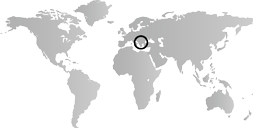This region of former Austrian and Ottoman provinces struggles with independence, with no set international borders or system for representing the different ethnic groups found here. The countries of the Balkan Peninsula are ravaged by wars and political upheavals throughout the twentieth century, from the Balkan Wars of the century’s second decade through the ethnic conflicts of the last. In between, repressive Communist regimes in many countries create a chilling climate for the arts. In many areas there exist local traditional cultures that are melded with international influences. In Turkey, for example, in the 1930s, the D Group of painters and sculptors seek to synthesize Turkish tradition with elements of avant-garde European art. Following the collapse of the Soviet Union and of repressive regimes in the Balkans in the early 1990s, opportunities open up for a less constrained art practice. Ongoing war, based on ethnic and other divisions, is an impediment to artistic practice in many areas through the 1990s. Greece remains stable, but the various kingdoms and federations established in the Balkans continually erupt into violence.


